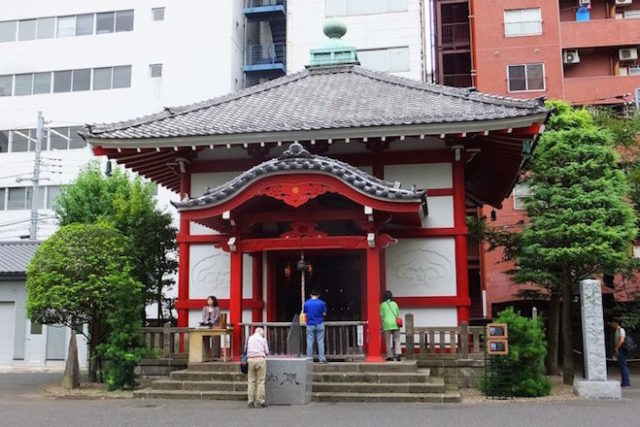By Yukiko Tanaka
Shinjuku 3-chōme, south of Kabukichō where Shinjuku-dōri and Meiji-dōri intersect, is among the most crowded spots in Shinjuku, but if you proceed on Shinjuku-dōri to 2-chome, you will be in a much quieter neighborhood. I am fond of this area partly because of Taiso-ji Temple, which sits in its corner.
Taiso-ji Temple is 400 years old. Although its compound is quite small and without a cemetery, it is worthwhile to visit because of the extra large statue of Jizo, the protector of children and pregnant women. Jizo’s size is remarkable in itself but the fact that the surface of its body is covered by thousands of names makes it very unusual. As you could guess, the names are those who contributed to fund it. Jizo, being the protector of travelers as well, makes this an apt spot since Shinjuku was the first shukuba post station of Koshu Highway in the Edo period. The area where Shinjuku Station stands today was Taiso-ji Temple’s monzen-machi, where a row of inns and restaurants lined the street interspersed with a house of prostitution. With the arrival of the Meiji era, the area became a “modern pleasure quarter” with cafés, although those “cafés” were not places to have coffee but instead were places for “specialized” business, meaning prostitution.
Later, as a law prohibiting prostitution was introduced, these “cafés” changed their businesses to inns, Turkish baths (Soap-land) and bars. The neighborhood of Shinjuku 2-chōme, where no less than 100 bars were crammed in, is a “gaytown” now, but coming from Kabuki-chō you find it much more quiet. According to some gay people, bars here are more comfortable in which to spend time. Although I paid much attention to introducing it as a particular kind of business such as those in “blue” and “red” light districts, Shinjuku as a whole encompasses quite varied neighborhoods.
6th and 7th chōme area, which are immediately north of Golden Alley, for example, is a quiet, residential area with streets lined primarily with houses but also a public bathhouse, a green grocery and such. Further toward the ward’s northeast corner, you will find neighborhoods with such names as Benten-chō and Yocho-machi, suggesting that the area’s history goes back to the Edo years, the same as with Araki-chō and Kagurazaka, both of which are not to be omitted in your walk of Shinjuku.






